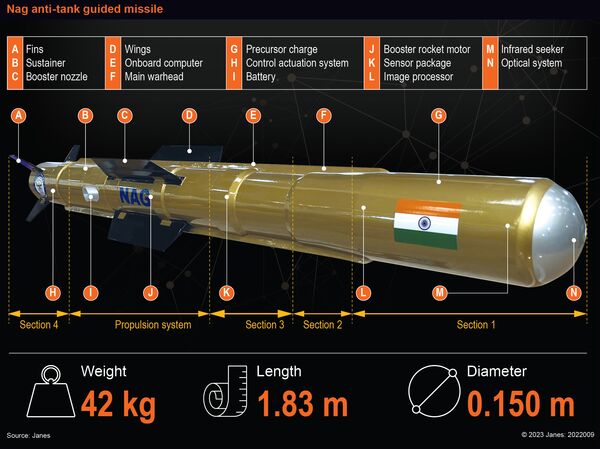
Nag anti-tank guided missile. (Janes)
India's Defence Research and Development Organisation (DRDO) recently confirmed to Janes that the Nag anti-tank guided missile (ATGM), the development of which was started in the 1980s, has cleared all the flight and user trials required for induction into the Indian Army. The DRDO is currently awaiting an order from the Indian Army for the missile, a DRDO official said.
The Nag ATGM was developed by Bharat Dynamics Limited (BDL) and the DRDO's Defence Research and Development Laboratory (DRDL) to meet an Indian Army requirement for a vehicle- and air-launched ATGM with a maximum range of 4 km.
The Nag is a tripod-mounted ATGM that can also be mounted on helicopters and the Nag Missile Carrier (NAMICA) armoured vehicle, a variant of the Russian BMP-2 Sarath developed by the DRDO.
For targeting, the Nag missile employs a passive mercury cadmium telluride (MCT) focal plane-array imaging infrared (IIR)/longwave IR (LWIR) seeker. The missile uses a lock-on before launch (LOBL) mode; however, it is designed with stretch potential for lock-on after launch (LOAL) capability, according to the DRDO.
Following launch, the roll, pitch, and yaw of the missile are controlled by rotating the rear fins with an all-electric actuation mechanism powered by thermal batteries.
The combined thrust of the booster and sustainer propulsion systems ejects the Nag from its launch tube, following which the fins unfold. It uses a high-energy nitramine-based, extruded double-band, smokeless sustainer propellant.
The missile uses an 8 kg tandem high-explosive anti-tank (HEAT) warhead. The warhead is capable of penetrating 800 mm of rolled homogeneous armour equivalent (RHAe) behind explosive reactive armour (ERA). The Nag has a length, diameter, and weight of 1.83 m, 0.15 m, and 42 kg respectively.
Looking to read the full article?
Gain unlimited access to Janes news and more...







